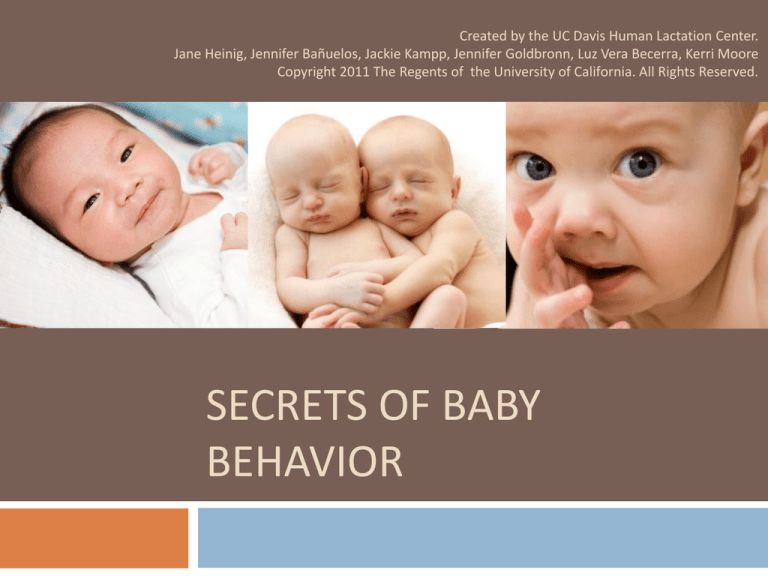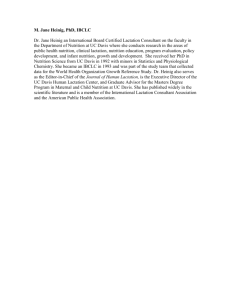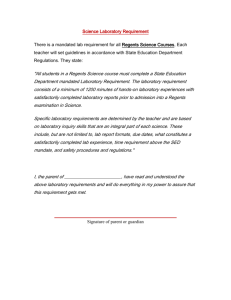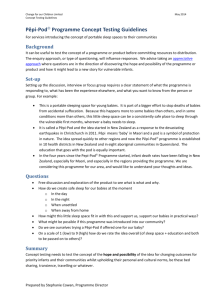
Created by the UC Davis Human Lactation Center.
Jane Heinig, Jennifer Bañuelos, Jackie Kampp, Jennifer Goldbronn, Luz Vera Becerra, Kerri Moore
Copyright 2011 The Regents of the University of California. All Rights Reserved.
SECRETS OF BABY
BEHAVIOR
Acknowledgement
Today’s program will be presented by:
Annmarie Golioto, MD, FAAP, Chief of Pediatrics and
Attending Neonatologist, Hospital of Central Connecticut
Q&A by:
Monica J. Belyea, MPH, RD; Center for Public Health and
Health Policy- University of Connecticut Health Center
The Secrets of Baby Behavior (SBB) training, for Federally Qualified Health Centers' (FQHC)
and this CT-AAP webinar, is offered through Connecticut Department of Public Heath with
grant funding from the Centers for Disease Control and Prevention's State Public Health
Actions to Prevent and Control Diabetes, Heart Disease, Obesity and Associated Risk Factors
and Promote School Health (CDC-RFA-DP13-1305).
http://www.cdc.gov/chronicdisease/about/state-public-health-actions.htm
Acknowledgement
This work has been funded in part with Federal
funds from the U.S. Department of Agriculture,
Food and Nutrition Service. The contents of this
presentation/publication do not necessarily reflect
the view or policies of the U.S. Department of
Agriculture, nor does mention of trade names,
commercial products, or organizations imply
endorsement by the U.S. Government.
The
Fit WIC Baby Behavior Study was funded by a
USDA WIC Special Projects Grant (2006-2009).
Created by the UC Davis Human Lactation Center.
Copyright 2011 The Regents of the University of California. All Rights Reserved.
Disclosure
I have no actual or potential conflicts of interest in
relation to this program/presentation.
I will not discuss any investigational or off-label use
of any drugs
Secrets of Baby Behavior Program
Recognition that inappropriate infant feeding
behaviors - link to child obesity
Infant feeding often linked to
misunderstanding of infant cues
Secrets of Baby Behavior approach to feeding:
Engage
parents and caregivers to understand behavior
Infant Crying, Infant cues, Infant Sleep
http://www.chdi.org/files/5214/1209/5014/preventing_childhood_obesity.pdf
Early childhood obesity
8.1% infants & toddlers over 95th percentile weight
for length NHANES 2012
Ogden
et. al. NHANES 2012, JAMA. 2014;311:806-814
Crossing more than 2 major growth percentiles
from birth – 6 mo associated with greater odds of
obesity at 5 y.o. and 10 y.o.
Tavaras et al. Arch Pediatr Adolesc Med. 2011;165(11):993998
Protective Effect of Breastfeeding
Fair evidence exists that BF inversely associated
with obesity; both length of breastfeeding and
exclusivity important.
Direct breastfeeding associated with improved
appetite control later
Disantis KI, et. al. Int J Behav Nutr Phys Act. 2011 Aug 17;8:89.
Li R, Fein SB, Grummer-Strawn LM. Pediatrics. 2010 Jun;125(6):e1386-93.
Bottle use rather than contents may be the risk
factor for obesity
Li R, et.al. Pediatr Adolesc Med. 2012 May;166(5):431-6.
CDC & P. Division of Nutrition and Physical Activity: Research to Practice Series No. 4. 2007
Bottle use in action
Created by the UC Davis Human Lactation Center. Copyright 2011 The
Regents of the University of California. All Rights Reserved.
CDC Breastfeeding Report Card
State
Ever Breastfed
Breastfeeding @ 6
months
Breastfeeding @ 12
months
U.S. National 2014
79.2%
49.4%
26.7%
Connecticut 2014
83.3%
51.4%
27.5%
Connecticut 2011
74.4%
47.1%
25%
State
Exclusive BF 3
months
Exclusive BF 6
months
% infants
receiving formula
before 2 days
U.S. National 2014
40.7%
18.8%
19.4%
Connecticut 2014
36.9%
19.2%
25.6%
Connecticut 2011
43.4%
16.2%
19.1%
http://www.cdc.gov/breastfeeding/pdf/2014breastfeedingreportcard.pdf
Infant Feeding Recommendations relative
to childhood obesity
Breastfeeding is associated
with decreased risk
Exclusive
Feed
for 6 months
by cues, not the clock
Early solid food introduction
related to increased risk
Wait
until developmentally
ready, not before 4-6 months
Monasta 2010; Stettler 2010; Grote 2011; Huh 2011
Created by the UC Davis Human Lactation Center.
Copyright 2011 The Regents of the University of California. All Rights Reserved.
Barriers to Compliance with Infant Feeding
recommendations
In a UC Davis study, the researchers
investigated why so many WIC mothers
in California stopped breastfeeding (or
gave formula in addition to breast
milk) in first few days postpartum
Some reported pain or problems but
many more reported insufficient milk
or that their babies were not satisfied
Citing Baby behavior as indicator
Created by the UC Davis Human Lactation Center.
Copyright 2011 The Regents of the University of California. All Rights Reserved.
Heinig et al. 2006
UC Davis Focus Groups
Many mothers believe babies cry because of
hunger (formula and cereal prevent hunger)
“When I gave formula,
the baby no longer cried
and that is when I
decided not to give him
breast milk.”
Heinig et al. 2006
Created by the UC Davis Human Lactation Center.
Copyright 2011 The Regents of the University of California. All Rights Reserved.
UC Davis Focus Groups
They believe babies wake because of
hunger
“The baby sleeps better with formula.”
“From the time she was maybe 3 or 4
months old, I started putting a little
cereal in her bottle, and it was at night.
It would help her; she would be full and
sleep through the night.”
Heinig et al. 2006
Created by the UC Davis Human Lactation Center.
Copyright 2011 The Regents of the University of California. All Rights Reserved.
UC Davis Focus Groups
They think their babies will stay full longer if
they are overfed
“My baby used to wake
up, but now I am giving
him formula even if he
is already full and he no
longer wakes up.”
Heinig et al. 2006
Created by the UC Davis Human Lactation Center.
Copyright 2011 The Regents of the University of California. All Rights Reserved.
Parents’ Unrealistic Expectations
Parents and other
caregivers have idealized
the “quiet, full, sleeping”
baby
“Real” babies wake and cry
Mom perceives there is no
solution to the problem of
trying to exclusively
breastfeed but baby still
cries at times throughout
day and night
Stern 1998; Heinig et al. 2006
Created by the UC Davis Human Lactation Center.
Copyright 2011 The Regents of the University of California. All Rights Reserved.
Emotional Regulation in Action
Believing there is no solution is like looking at a brick wall
“ I can’t do this…”
Created by the UC Davis Human Lactation Center.
Copyright 2011 The Regents of the University of California. All Rights Reserved.
USDA WIC Special Projects Grant
UC Davis Human
Lactation Center and
California WIC
partnered for a 3-year
USDA WIC Special
Projects Grant (20062009)
Created by the UC Davis Human Lactation Center.
Copyright 2011 The Regents of the University of California. All Rights Reserved.
Study Design
3-year quasi-randomized educational
intervention (8 sites in CA)
1
year intervention period
Concept: Create a clinic environment
supporting positive caregiver-infant interactions
Training,
social marketing, handouts, classes,
activities
Effort to create messaging that can be delivered
quickly, effectively, and inoffensively
http://www.nal.usda.gov/wicworks/Sharing_Center/statedev_FIT.html
Created by the UC Davis Human Lactation Center.
Copyright 2011 The Regents of the University of California. All Rights Reserved.
Baby Behavior Education
Goal: Provide parents with
anticipatory guidance and the
skills to interact more
effectively with their infants
Addresses
“trigger” behaviors
that result in overfeeding or
inappropriate feeding practices
http://www.nal.usda.gov/wicworks/Sharing_Center/statedev_FIT.html
Created by the UC Davis Human Lactation Center.
Copyright 2011 The Regents of the University of California. All Rights Reserved.
Breastfeeding Rates CA WIC Infants
0-2 Months
Percent of Participants
70
Combo
60
Excl
50
40
30
20
10
0
2006
2007
2008 2009
Year
Source: CA State WIC ISIS Data
2010
2011
Infants >95th percentile wt/age
Attained weight-for-age
> 95th percentile (5-7
months-of-age)
Baseline: N = 339
Post: N = 411
* P < .01
20
18
16
14.4
14
12
10
12.6
10.7
Int
Control
8
6
4.9
4
2
0
Baseline
Created by the UC Davis Human Lactation Center.
Copyright 2011 The Regents of the University of California. All Rights Reserved.
Post
WHO growth standards
Secrets of Baby Behavior
Infant States
Created by the UC Davis Human Lactation Center.
Copyright 2011 The Regents of the University of California. All Rights Reserved.
Infant States
Crying
Irritable
Quiet Alert
Drowsy
Active Sleep
Quiet Sleep
Intensity
All babies move
through these 6
states…
…but not always in a
predictable way!
Created by the UC Davis Human Lactation Center.
Copyright 2011 The Regents of the University of California. All Rights Reserved.
Quiet Alert
Little body
movement
Eyes open and wide
Steady, regular
breathing
Highly responsive
Wants to learn and
play – interactive
Tiring! This state
requires effort to
control.
Key Message: Moms feel rested, but babies
work hard during quiet alert periods
Created by the UC Davis Human Lactation Center.
Copyright 2011 The Regents of the University of California. All Rights Reserved.
Changing States
Babies can move through the states on their own, but sometimes
they will need a caregiver’s help moving from one state to another…
Variety to Waken
Use different positions, touch, &
words
Will take longer if very drowsy
or in deep sleep
Can take up to 10 to 15 minutes
for very young infants to wake
up enough to eat well
Repetition to Soothe
Address the child’s needs – see
if change in position or
circumstances helps
Repeat actions or words over
and over
May take time if infant is very
upset
Barnard 2010
Created by the UC Davis Human Lactation Center.
Copyright 2011 The Regents of the University of California. All Rights Reserved.
Key Messages for Parents
Sleepy babies need lots
of stimulation
Using the same actions
and sounds over and
over will calm
overstimulated babies
Parents should be
patient
Listen for a change in the cry for a
few minutes before trying
something else
Secrets of Baby Behavior
Infant Cues
Created by the UC Davis Human Lactation Center.
Copyright 2011 The Regents of the University of California. All Rights Reserved.
Types of Infant Cues
Infant cues are specific behaviors (movements,
noises, etc) babies use to communicate what
type of interaction, if any, they need
Engagement
cues – behaviors that indicate that a
baby wants to interact
Disengagement
cues – behaviors that indicate that a
baby needs something to be different
Kelly et al. 2003
Created by the UC Davis Human Lactation Center.
Copyright 2011 The Regents of the University of California. All Rights Reserved.
Engagement Cues
Looking intently at face
Eyes open
Rooting
Face relaxed
Feeding sounds
Feeding posture
Smiling
Raising head
Smooth body
movements
Following voice and
face
Kelly et al. 2003
Created by the UC Davis Human Lactation Center.
Copyright 2011 The Regents of the University of California. All Rights Reserved.
Engagement Cues
Created by the UC Davis Human Lactation Center.
Copyright 2011 The Regents of the University of California. All Rights Reserved.
Disengagement Cues
Turns away
Looks away
Pushes, arches away
Faster breathing
Crying
Yawning
Choking, coughing
Hand to ear
Extending fingers, stiff
hands
Grimace
Glazed look
Falling asleep
Kelly et al. 2003
Created by the UC Davis Human Lactation Center.
Copyright 2011 The Regents of the University of California. All Rights Reserved.
Disengagement Cues
Created by the UC Davis Human Lactation Center.
Copyright 2011 The Regents of the University of California. All Rights Reserved.
Clustered Cues: Hunger
Clenched fingers
& fists over
chest & tummy
Flexed arms &
legs
Rooting
Fast breathing
Sucking
noises/motions
Key Message: A hungry baby will give several
cues together to alert caregivers
Created by the UC Davis Human Lactation Center.
Copyright 2011 The Regents of the University of California. All Rights Reserved.
Key Messages for Parents
Cues are simplistic
and NOT specific
Parents may need to “play
detective” to figure out what
their babies are trying to tell
them
When babies’ cues are not
addressed, they “escalate”
For most healthy term
babies, feeding cues
are obvious
Secrets of Baby Behavior
Infant Crying
Created by the UC Davis Human Lactation Center.
Copyright 2011 The Regents of the University of California. All Rights Reserved.
Crying: Babies’ “Super Power”
Crying results in a sound that
affects the nervous system in
most adults
Drives
adult activity!
Needs to be stressful in order
to motivate caregiver
Must be loud to rouse
sleeping caregivers
Important skill
St. James-Roberts 2001
Created by the UC Davis Human Lactation Center.
Copyright 2011 The Regents of the University of California. All Rights Reserved.
“Normal” Crying
ALL infants cry
Crying
is used to communicate needs
Many
newborns cry more than older infants as they
adapt to their new postnatal environment and struggle
to provide readable cues
As adults respond to cues and babies refine their
cues, crying lessens – any responsive caregiver can
assist in this process
Hiscock H. 2006; Nugent 2007
Created by the UC Davis Human Lactation Center.
Copyright 2011 The Regents of the University of California. All Rights Reserved.
Assessing Crying: Challenges
Parents perceive crying as
continuous even though babies
typically cry in short bursts
Tolerance for crying may
influence perceived duration
Ability to calm a crying baby
associated with parenting
confidence
Green 2001; Leavitt 2001
Created by the UC Davis Human Lactation Center.
Copyright 2011 The Regents of the University of California. All Rights Reserved.
Is There a “Hungry Cry”?
How can caregivers tell when a crying baby is
hungry?
Hungry babies might cry but they will ALSO bring
their hands to their face, clench their hands, flex
their arms and legs, root, make sucking motions and
noises
All these behaviors together help us know when a
baby is hungry
All hungry babies should be fed!
Sumner 1994
Created by the UC Davis Human Lactation Center.
Copyright 2011 The Regents of the University of California. All Rights Reserved.
Caregivers can help crying babies
(who have been fed) by:
Promoting self-soothing skills
Letting babies suck: hands/pacifier
Showing their faces to babies
Using “repetition to soothe”
Speaking softly over and over
Holding, rocking, stroking the baby over and over
One action at a time, avoid overstimulation
Babies will take longer to calm down if they are very young or
very upset-persist with one action before trying another
Created by the UC Davis Human Lactation Center.
Copyright 2011 The Regents of the University of California. All Rights Reserved.
Kelly et al. 2003; Nugent 2007
Secrets of Baby Behavior
Infant Sleep
Created by the UC Davis Human Lactation Center.
Copyright 2011 The Regents of the University of California. All Rights Reserved.
Misconceptions about Infant Sleep
Many parents thought babies would either
sleep through the night OR wake up all night long
“Good”
babies sleep through the night
If babies do not sleep through the night, they will
“wake constantly”
Goal becomes to “fix” the infant’s sleep “problem,”
rather than addressing the normal sleep
deprivation caregivers feel related to the infant’s
need for care in the night
Heinig 2006; UC Davis Human Lactation Center (unpublished); Wolfson 1992
Created by the UC Davis Human Lactation Center.
Copyright 2011 The Regents of the University of California. All Rights Reserved.
Infant Sleep States
Active Sleep is Light Sleep
Important for brain
development
Dreaming results in REM
Images stimulate
brain function
Blood flow to the brain
is increased, bringing
nutrients to active
brain cells
Quiet Sleep is Deep Sleep
Important for the
brain to rest and
recover
No dreaming
Memory development
and growth
Peirano et al. 2003; Barnard 2010; Heraghty et al. 2008; Graven & Browne 2008; Nugent 2007
Created by the UC Davis Human Lactation Center.
Copyright 2011 The Regents of the University of California. All Rights Reserved.
Newborn Sleep/Wake Cycle
Wake
Active
Sleep
Newborns start sleep in Active Sleep,
dreaming for 20-30 minutes, and
move to Quiet Sleep
½ of their sleep in Active Sleep, ½ in
Quiet Sleep
Initially, newborns will wake with
each cycle (every 1-2 hours)
Quiet
Sleep
Small stomachs = frequent feeds
Infants who are sensitive to position
changes may wake up easily when
put down in Active Sleep
Heraghty et al. 2008; Hoppenbrouwers et al. 1988; Peirano et al. 2003
Created by the UC Davis Human Lactation Center.
Copyright 2011 The Regents of the University of California. All Rights Reserved.
2-Month-Old Sleep/Wake Cycle
Infants begin with shorter periods of Active
Sleep then move into Quiet Sleep
They start to have longer
quiet sleep periods at
night
Parmelee 1964
Created by the UC Davis Human Lactation Center.
Copyright 2011 The Regents of the University of California. All Rights Reserved.
Older Infant Sleep/Wake Cycle: 3+ months
Sleep patterns become more
consistent over time
More likely to fall asleep into
Quiet Sleep
Sleep patterns follow the
light-dark cycle
Able to sleep longer stretches
during the nighttime
Heraghty et al. 2008; Jenni and LeBourgeois 2006; Peirano et al. 2003; Parmelee 1964
Created by the UC Davis Human Lactation Center.
Copyright 2011 The Regents of the University of California. All Rights Reserved.
Reasons for Excessive Waking
Baby’s body is immature – can’t maintain sleep state
or tune out stimulation
Illness or injury
TV in room (or other intermittent stimulation/noise)
Caffeine or med exposure(breastfeeding mothers)
Change in routine
Baby is hungry
May need to refer to provider
Goodlin-Jones et al. 2001; Barnard 2010; Trachtenbarg and Golemon 1998; Sadeh and Anders 1993;
Tirosh et al. 1993; Nugent 2007; Lawrence 2010; Liston 1998
Created by the UC Davis Human Lactation Center.
Copyright 2011 The Regents of the University of California. All Rights Reserved.
Infant Feeding and Sleep
Breastfed infants have more Active Sleep
More
likely to wake up if uncomfortable or need
parental assistance
Reduced risk of SIDS in BF babies may be linked to
ability to awaken more easily
Promote Active Sleep by putting babies “back to
sleep” or using pacifiers after BF established
However, no significant difference in maternal
sleep by feeding method
McVea 2000; Horne et al. 2004; Rosen 2008; Montgomery-Downs et al. 2010
Created by the UC Davis Human Lactation Center.
Copyright 2011 The Regents of the University of California. All Rights Reserved.
Key Messages: Infant Sleep
Infant sleep patterns change. As infants get older:
They
Will
sleep for longer stretches
be more likely to fall asleep in Quiet Sleep state
Encourage
caregivers can look for signs of Quiet Sleep
before laying baby down
Active sleep and night waking are beneficial
Babies
wake more easily when in Active Sleep
Waking
may be essential for survival
Dreaming
is important for brain development
Created by the UC Davis Human Lactation Center.
Copyright 2011 The Regents of the University of California. All Rights Reserved.
Secrets of Baby Behavior
Caregiver-Infant Interactions
Created by the UC Davis Human Lactation Center.
Copyright 2011 The Regents of the University of California. All Rights Reserved.
Successful Interactions take 3 Steps
Caregiver needs to LOOK at the baby
Caregiver needs to RECOGNIZE what the
baby needs
Caregiver needs to know how to
RESPOND appropriately
Schiffman 2003
Created by the UC Davis Human Lactation Center.
Copyright 2011 The Regents of the University of California. All Rights Reserved.
Look
What are some reasons
that caregivers would not
be looking at their
babies?
Created by the UC Davis Human Lactation Center.
Copyright 2011 The Regents of the University of California. All Rights Reserved.
Recognize
Caregivers who don’t recognize their babies’ cues
will seem frustrated with their babies’ behavior
“She
cries all the time.”
“She’s constantly hungry.”
“My mom says I should just let her cry.”
Parents believe behavior is “random” or “comes
out of nowhere”
They may assume that their babies are thinking like older
children or adults- exhibiting “controlling” behaviors
They may be concerned about “spoiling” the baby
Created by the UC Davis Human Lactation Center.
Copyright 2011 The Regents of the University of California. All Rights Reserved.
Respond
Caregivers who respond inappropriately
Respond
Get
to almost every cue by feeding the baby
frustrated if the baby does not react immediately
May
result in interactions that make things worse
Escalation
of cues, crying, and increased stress
Barriers to appropriate response
Lack
of knowledge or comfort with baby
Lack
of confidence
Created by the UC Davis Human Lactation Center.
Copyright 2011 The Regents of the University of California. All Rights Reserved.
Promoting Positive Interactions
Created by the UC Davis Human Lactation Center.
Copyright 2011 The Regents of the University of California. All Rights Reserved.
Engage and validate the caregiver:
What to say …”Look!”
Say something nice about the
baby’s ability to communicate with
that caregiver
“Aren’t babies amazing, they can to
tell us what they want with their
bodies and their noises….”
Help them see what their babies
are telling them
“Mom, I’m waving my arms to get
your attention…”
Created by the UC Davis Human Lactation Center.
Copyright 2011 The Regents of the University of California. All Rights Reserved.
Provide Basic Information: “Recognize”
Describe the cue being given, when it is used, and
how it differs from other cues
“Isn’t it wonderful that your baby can tell you
what he wants? Every baby is different but it
looks like your baby wants you to…”
Support the caregiver as she
tries to recognize her baby’s
cues by asking her to verify
your perception or ask for
her ideas
Created by the UC Davis Human Lactation Center.
Copyright 2011 The Regents of the University of California. All Rights Reserved.
Provide Basic Information: “Respond”
Help caregiver check for obvious reasons - diaper,
hunger, etc.
Support
the caregiver’s efforts to respond
Not obvious?
Help
caregiver to look for patterns of engagement or
disengagement cues to guide response
Play
detective to identify reason(s)
Still crying?
Repetition
to soothe
Created by the UC Davis Human Lactation Center.
Copyright 2011 The Regents of the University of California. All Rights Reserved.
Keep it Simple & Relevant
Important to provide simple messages (caregivers
are often tired and overwhelmed)
Messages must be relevant to the caregiver’s
needs and concerns
What
do they need at that moment to feel better
about handling baby?
More than one source of information is best
Consistent
messaging needed across settings (nurses,
doctors, hospital staff, office staff, WIC staff)
More exposure = more learning
Created by the UC Davis Human Lactation Center.
Copyright 2011 The Regents of the University of California. All Rights Reserved.
Supplemental Reference List
http://www.cdph.ca.gov/programs/wicworks/Pages/WICCaliforniaBabyBehaviorCampaig
n.aspx
Disantis KI, et. al. Do infants fed directly from the breast have improved appetite
regulation and slower growth during early childhood compared with infants fed from a
bottle? Int J Behav Nutr Phys Act. 2011
Aug 17;8:89. http://www.biomedcentral.com/content/pdf/1479-5868-8-89.pdf
Li R, Fein SB, Grummer-Strawn LM. Do Infants Fed From Bottles Lack Self-regulation of
Milk Intake Compared With Directly Breastfed Infants? Pediatrics. 2010
Jun;125(6):e1386-93.
http://pediatrics.aappublications.org/content/125/6/e1386.long
Li R, et.al. Risk of Bottle-feeding for Rapid Weight Gain During the First Year of Life, Arch
Pediatr Adolesc Med. 2012 May;166(5):431-6.
http://archpedi.jamanetwork.com/article.aspx?articleid=1151630
Ogden et. al. Prevalence of Childhood and Adult Obesity in the United States, 2011-2012.
JAMA. 2014;311:806-814. http://jama.jamanetwork.com/article.aspx?articleid=1832542
Created by the UC Davis Human Lactation Center. Copyright 2012 The
Regents of the University of California. All Rights Reserved.
Ogden et. al. Prevalence of High Body Mass Index in US Children and Adolescents,
2007-2008. JAMA. 2010;303:242-249.
http://jama.jamanetwork.com/article.aspx?articleid=185233
Pérez-Escamilla, R. and Judith Meyers, Preventing Childhood Obesity: Maternal/Child
Life Course Approach. Accessed via:
http://www.chdi.org/files/5214/1209/5014/preventing_childhood_obesity.pdf
Taveras et al. Crossing Growth Percentiles in Infancy and Risk of Obesity in Childhood.
Arch Pediatr Adolesc Med. 2011;165(11):993-998.
http://archpedi.jamanetwork.com/article.aspx?articleid=1107637
Taveras et al. Reducing Racial/Ethnic Disparities in Childhood Obesity: The Role of
Early Life Risk Factors. JAMA Pediatr. 2013;167(8):731-738.
http://archpedi.jamanetwork.com/article.aspx?articleid=1692336
CDC & P. Division of Nutrition and Physical Activity. Does breastfeeding reduce the risk
of pediatric overweight? Research to Practice Series No. 4. 2007. Accessed via:
http://www.cdc.gov/nccdphp/dnpa/nutrition/pdf/breastfeeding_r2p.pdf
CDC &P. Breastfeeding Report Card 2014. Accessed via:
http://www.cdc.gov/breastfeeding/data/reportcard.htm
Created by the UC Davis Human Lactation Center. Copyright 2012 The
Regents of the University of California. All Rights Reserved.





